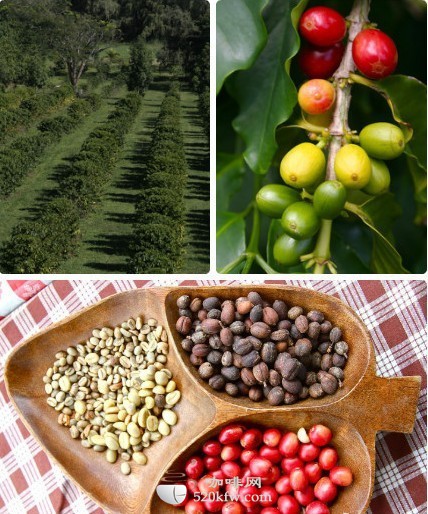Coffee Common sense Coffee Special Classification system

Special coffee classification system:
1. Subgenus Coffea:
two。 Malagasy coffee subgenus:
3. Subgenus Pala coffee:
4. Subgenus Argophora:
Subgenus Coffea:
A, red fruit coffee group:
B, thick skin Coffee Group:
C, Mozambique Coffee Group:
D, black fruit coffee group
E, gnome Coffee Group:
Red fruit coffee group:
A) Arabica species:
Tibica varieties: (Tpica)
Features: thin and tall appearance, low yield, reddish brown top leaves, elegant flavor, poor disease resistance.
Elephant beans:
1870 characteristics in Brazil: low fruit yield and large beans. Colombia, Guatemala, Nicaragua, El Salvador and so on have been planted.
Tibica the gnome:
Douxiao was born in Ethiopia, the tree is short and the leaves are small, and the beans are exquisite and lovely, which is different from the beans that are longer than iron cards. The Dutch transplant Sulawesi.
Kona Tibica:
Tibica in the Big Island of Hawaii is from Guatemala. The subtropical temperature at 20 degrees north latitude is cool, giving a clean sour and sweet feeling.
Blue Mountain Tibica:
Dikrou, a French officer, sent Tibica saplings to Martinique in 1720. 1725 the British Governor will transplant the Blue Mountains of Jamaica. After 200 years, the disease resistance of Blue Mountain Tibica is better than that of ordinary Tibica.
Kent:
The British contributed a lot to Indian coffee breeding. Kent, a British horticulturist, screened resistant varieties (Kent) in Karnataka, India, from 1918 to 1920.
K7
The drought-resistant Tibica variety cultivated by French missionaries in Kenya has disease resistance and is most suitable for planting in areas with severe disasters at low elevations. K7 is very popular in Australia, and commercial planting is also available in Yunnan.
Wampee wave card map:
The Tibica variety found in India turns yellow as a result of maturity and produces few fruits and is cultivated in Brazil. The winner of the Brazilian Cup test, Huang Bourbon, is a hybrid of wampee bourbon and red bourbon.
Bourbon species:
Features: medium-high appearance, low fruit yield, green top leaves, excellent acidity and poor virulence.
El Salvador bourbon:
Kaddura
Kaddura was discovered in Brazil in 1935 as a "green-top" dwarf bourbon with obvious waxy leaves, short internodes of branches, clusters of fruit and yield 200kg higher than bourbon. Replacing Tibica and Bourbon in one fell swoop, it is an important variety with both quality and quality in the "New World" at present.
Pacas
A variety of dwarf plant bourbon found around 1950 by a farmer named Pacas in the Santa Ana producing area of El Salvador. The tree is shorter and stronger than Kaddura. Pacas is also one of the parents of the popular hybrid Pacamara in recent years.
Vera Loeb.
Found at Vera Loeb Manor, a well-known coffee family in Costa Rica. Is a bourbon short variety, characterized by the fruit than the general iron card or bourbon is more resistant to strong wind, not easy to blow off, fruit yield is not low, fruit acidity is also more docile, caramel aroma protruding.
Vera Saatchi
The bourbon dwarf variety, 1950 found in the village of Saatchi in the western valley of Costa Rica, is the most suitable for high-altitude organic cultivation, with strong acid activity and obvious caramel flavor. The output is not much.
Bourbon pointed body
The Bourbon dwarf plant was found on the French island of Bourbon in 1810. The bean appearance is not the short circle that Bourbon is accustomed to, but is pointed and thin. Her yield is the lowest in the Bourbon dwarf series, weak and sickly. The characteristic is that caffeine is only half that of the average Arabica. It can be described as natural semi-decaf coffee.
Mocha
The mocha tree is short, the coffee beans are also exquisite and lovely, it is a variety of bourbon, and the caffeine is low. Hawaii has found that mocha and Tibicado hand over mixed-race mocha. The tree is taller and is planted on Weiyi lovely island.
SL28/SL34
A drought-resistant bourbon variety cultivated by botanists from French missionaries at the Kirkot Laboratory in Kenya from 1930 to 1940.
Geisha species:
Central American geisha: divided into green top and red top.
Kaddura species:
Kaddura is a "green-topped" dwarf bourbon discovered in Brazil in 1935.
Cameroun species:
The interspecific hybrid between Kaddura and Timor was successfully bred in 1959.
SL34/SL28
Malago Gibbs (elephant beans)
B) Canifera species:
Robasta:
Nganda:
C) Congo Sith species:
D) Eugenio species:
Intraspecific hybrid series: Arabica with Arabica
1. Central American geisha:
two。 Ethiopian geisha:
3. Huang Bourbon:
4. Kaduai:
5. Akaia:
6. Pacamara:
7. Mara Kadura:
8. The giant Mara Kadura:
Interspecific hybrid series: Arabica with non-Arabica
1, Timorese hybrid breed:
2, Alabasta:
3, Cameroun:
4, Colombia:
5, Batian:
6, Ikatu:
7, Obata:
8, Rasuna:
Important Notice :
前街咖啡 FrontStreet Coffee has moved to new addredd:
FrontStreet Coffee Address: 315,Donghua East Road,GuangZhou
Tel:020 38364473
- Prev

Hand-made coffee-- questions and answers on flannel filter cloth
Today, I use French blue velvet filter cloth to make Brazilian Syrador. I make a cup of water at a temperature of about 85 to 88 and a particle size of 3.5 in a small, medium-sized way. 2 flat tablespoons, but found that the coffee tastes strange ~ no acidity and sweet taste, a mediocre feeling, like a breeze with no special coffee flavor. So I decided to use the filter paper to make a cup in my hand and found that the smell came out.
- Next

The advantages and disadvantages of drinking coffee regularly
The pros and cons of drinking coffee: close contact with coffee caffeine can stimulate the central nervous system and muscles, so it can cheer up, enhance thinking ability, and restore muscle fatigue. Acting on the cardiovascular system, it can improve heart function, dilate blood vessels and promote blood circulation. For the gastrointestinal system, it can help digestion and help decompose fat.
Related
- What brand of black coffee is the most authentic and delicious? what are the characteristics of the flavor of the authentic Rose Summer Black Coffee?
- Introduction to the principle and characteristics of the correct use of mocha pot A detailed course of mocha pot brewing coffee is described in five steps.
- Which is better, decaf or regular coffee? how is decaf made?
- How much is a bag of four cat coffee?
- How about four Cat Coffee or Nestle Coffee? why is it a cheap scam?
- Which is better, Yunnan four Cats Coffee or Nestle Coffee? How about cat coffee? is it a fake scam? why is it so cheap?
- How about Cat Coffee? what grade is a hoax? which instant coffee tastes better, four Cat Coffee, Nestle Coffee or G7 coffee?
- Process flow chart of coffee making-Starbucks coffee making process what coffee tastes good at Starbucks
- The top ten best coffee beans in the world Rose summer coffee or Tanzanian coffee tastes good
- Yunnan four cat coffee is good to drink?_four cat coffee is a big brand? four cat blue mountain coffee is fake?

